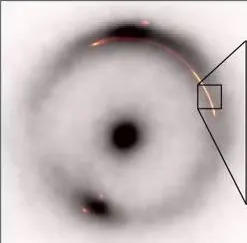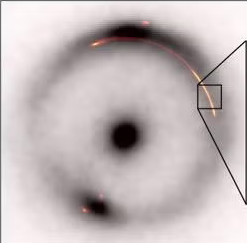A mysterious object found deep in the cosmos could soon have astronomers rethinking what they know about dark matter.
That’s according to a team of researchers who turned to a global network of telescopes to spot what they believe could be a clump of dark matter. Though it’s a million times the mass of our sun, the object could only be found by a tiny distortion caused by its gravity, according to a press release announcing the discovery.
What’s more, its impressive size actually makes it somewhat diminutive when compared with other dark matter discoveries. In fact, the team of astronomers who located it say it’s the lowest-mass dark object yet found in space.
And its existence could reveal more about the nature of the cryptic dark matter that makes up more than a quarter of the universe, the researchers claimed.
Vera C. Rubin Observatory reaches for the stars: Take a look
1 of 11
The multi-colored tracks of asteroids flash on and off in this image of two spiral galaxies within the Virgo Cluster. Each of these tracks represents a moving asteroid detected by NSF–DOE Vera C. Rubin Observatory in its first few nights of observations.
Here’s everything to know about the new discovery.
Gravitational lensing helps astronomers detect mystery object
The black ring and central dot show an infrared image of a distant galaxy distorted by a gravitation lens. The orange/red coloring depicts radio waves.
A worldwide network of radio telescopes, including the Green Bank Telescope in West Virginia and the Very Long Baseline Array in Hawaii, helped astronomers detect the mysterious object in question.
With a mass of about 1 million times that of Earth’s sun, the object is considered the lowest-mass dark object yet found in the universe by analyzing gravitational distortions of light, according to the team of researchers.
Because the object does not emit light or radiation, it was detected in a process called gravitational lensing. As first predicted by Albert Einstein, gravitational lensing occurs when a massive celestial body causes a sufficient curvature of space-time for the path of light around it to be visibly bent, as if by a lens.
Because of the way the phenomena appears to those using a telescope, they’re referred to as Einstein Rings.
The team said they analyzed the way the object’s gravity distorted light to determine the approximate amount of matter composing it.
“It’s an impressive achievement to detect such a low-mass object at such a large distance from us,” study coauthor Chris Fassnacht, an astronomer at the University of California, Davis, said in a statement. “Finding low-mass objects such as this one is critical for learning about the nature of dark matter.”
What is dark matter?
Ordinary matter makes up everything from the cosmic (planets and stars) to the earthly (people and trees). But while normal matter makes up everything we encounter in our daily lives, it only accounts for about 5% of matter in all of the known universe, according to NASA.
Ordinary matter emits light in various wavelengths, which allows it to easily be seen.
The vast majority of matter, however, is dark – unseen until it is detected only through its gravitational effects.
While dark matter has gravity and makes up a significant 27% of the universe, “it is invisible and isn’t like anything else we know about,” NASA explains online. Scientists aren’t even really sure what it is, though they do have theories – including that it is unidentified types of particles, according to NASA.
Scientists know even less about dark energy, which makes up the remaining 68% of the universe.
Low-mass space object could also be inactive dwarf galaxy
The newly discovered object could be a clump of dark matter 100 times smaller than any of its kind previously detected, according to the new research. Or, the researchers theorized, it could also be a compact, inactive dwarf galaxy much smaller than our Milky Way.
Whichever the case, the researchers are now curious to discover more characteristics of the intriguing object, including determining whether dark matter can exist in small clumps without stars. The team continues to analyze the data to better understand the dark object’s nature while also looking for additional similar objects.
The research is described in two studies published Oct. 9 in Nature Astronomy and Monthly Notices of the Royal Astronomical Society.
(This article has been updated to add new information.)
Eric Lagatta is the Space Connect reporter for the USA TODAY Network. Reach him at elagatta@gannett.com
This article originally appeared on USA TODAY: Astronomers spot mystery object in distant universe. What is it?

